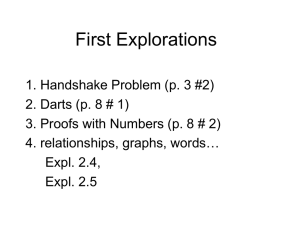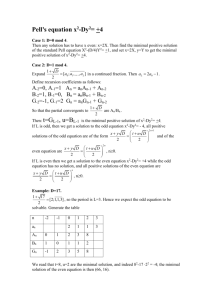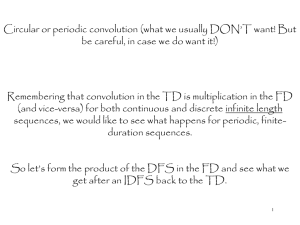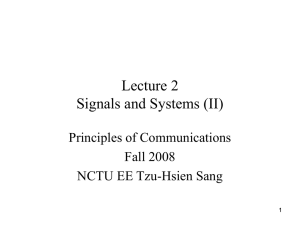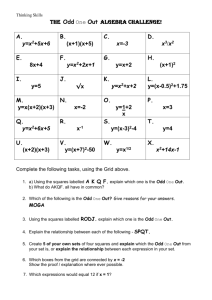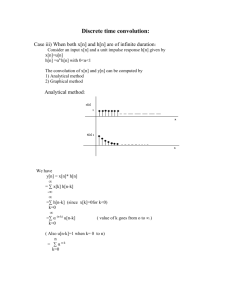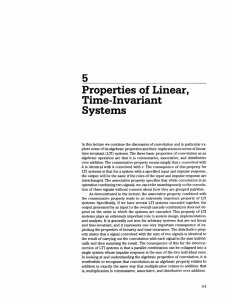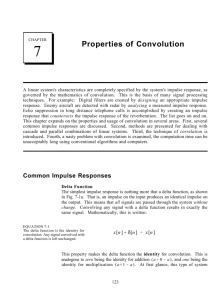review303test1
advertisement
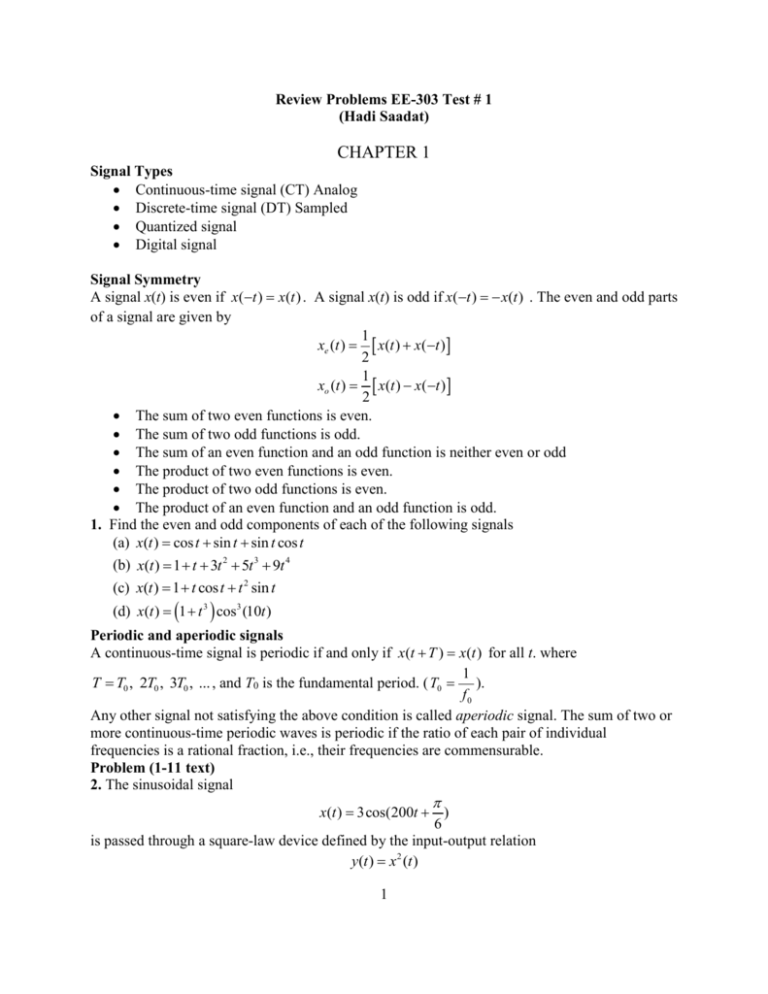
Review Problems EE-303 Test # 1 (Hadi Saadat) CHAPTER 1 Signal Types Continuous-time signal (CT) Analog Discrete-time signal (DT) Sampled Quantized signal Digital signal Signal Symmetry A signal x(t) is even if x(t ) x(t ) . A signal x(t) is odd if x(t ) x(t ) . The even and odd parts of a signal are given by 1 xe (t ) x(t ) x( t ) 2 1 xo (t ) x(t ) x( t ) 2 The sum of two even functions is even. The sum of two odd functions is odd. The sum of an even function and an odd function is neither even or odd The product of two even functions is even. The product of two odd functions is even. The product of an even function and an odd function is odd. 1. Find the even and odd components of each of the following signals (a) x(t ) cos t sin t sin t cos t (b) x(t ) 1 t 3t 2 5t 3 9t 4 (c) x(t ) 1 t cos t t 2 sin t (d) x(t ) 1 t 3 cos3 (10t ) Periodic and aperiodic signals A continuous-time signal is periodic if and only if x(t T ) x(t ) for all t. where 1 T T0 , 2T0 , 3T0 , ... , and T0 is the fundamental period. ( T0 ). f0 Any other signal not satisfying the above condition is called aperiodic signal. The sum of two or more continuous-time periodic waves is periodic if the ratio of each pair of individual frequencies is a rational fraction, i.e., their frequencies are commensurable. Problem (1-11 text) 2. The sinusoidal signal x(t ) 3cos(200t ) 6 is passed through a square-law device defined by the input-output relation y(t ) x 2 (t ) 1 Show that the output y(t) consists of a dc component and a sinusoidal component. (a) Specify the dc component (b) Specify the amplitude and fundamental frequency of the sinusoidal component in the output y(t). Phasor signals and Spectra A complex signal is defined as x(t ) Ae j (0t ) Xe j0t where X Aei A is a rotating phasor. The sinusoidal signal x(t ) A cos(0t ) may be written as the real part of the rotating phasor, i.e., x(t ) Xe j0t . Alternatively, x(t) may be written as one-half of the counter rotating signals, i.e., 1 x(t ) x(t ) x (t ) 2 An alternative way to visualize the sinusoidal signal x(t) in the frequency domain is in the form of two plots. One the amplitude A as the function of frequency f, and the other its phase angle as a function of f. These plots are referred to as single-sided spectra. If the amplitude and phase angle plots are made for the oppositely rotating phasors we obtain the so-called double-sided spectra. Problems (1-12, 1-43 text) Singularity functions, signal description, sketching signals, and operation on signals Examples of singularity functions are: unit impulse (t ) , unit step u (t ) , and unit ramp r (t ) . d d r (t ) tu (t ) u (t ) r (t ) (t ) u (t ) dt dt More complex functions can be built up of sums or products of singularity functions. An impulse signal is mathematically described by (t ) 0 for t 0 and - (t )dt 1 An important property of an impulse signal is the sifting property x(t ) (t t0 ) x(t0 ) Another commonly used signal is the pulse signal x(t ) (t ) , defined as 1 1 t 1 (t ) 2 2 otherwise 0 Time Shift: If x(t) is a continuous function, the time-shifted signal is defined as y(t ) x(t t0 ) . If t0 > 0, the signal is shifted to the right, and if t0 < 0, the signal is shifted to the left. Time Reversal: If x(t) is a continuous function, the time-reversed signal is defined as y(t) = x(-t). Time Scaling: If x(t) is a continuous function, a time-scale version of this signal is defined as y(t) = x(at). If a >1, the signal y(t) is a compressed version of x(t), i.e., the time interval is 1 compressed to . If 0 < a < 1, the signal y(t) is a stretched version of x(t), i.e., the time interval a 2 1 . When operating on signals, the time-shifting operation must be performed a first, and then the time-scaling operation is performed. Problems (1-14, 1-18, 1-22, 1-26 text) 3. A triangular pulse signal x(t) is depicted below. is stretched by x(t ) 1 -1 0 t 1 Sketch each of the following signals: (a) x(3t ) (b) x(3t 2) (c) x(2t 1) (d) x(0.5t 1) Energy and power signals The energy of a CT signal x(t) is given by T E lim | x 2 (t ) | dt T T The power of a CT signal x(t) is given by 1 T 2 1 T2 2 P lim | x ( t ) | dt or P lim T | x (t ) | dt T 2T T T T 2 1 T 2 Energy in oneperiod and X rms P For periodic signals P | x (t ) | dt T 0 T For discrete-time signals 1 N 1 N 1 E | x 2 [ n] | P lim | x 2 [ n] | For periodic DT signal P | x 2 [n] | N N N 0 n N Energy signal is a signal with a finite energy and zero power. A power signal is a signal with nonzero power and infinite energy. All periodic signals are power signals. Signal energy for three useful pulse shapes are A x(t ) b t Rectangular pulse E A2b A A x(t ) x(t ) b t Half-cycle sinusoid pulse E Problems (1-33, 1-34, 1-38 text) 3 1 2 Ab 2 b Triangular pulse E 1 2 Ab 3 Power Spectral Density Denoting the energy spectral density of a signal x(t ) by G ( f ) , the signal energy is E G( f )df Denoting the power spectral density of a signal x(t ) by S ( f ) , the average power of the signal is P S ( f )df Problems (1-44, 1-45 text) CHAPTER 2 System Classification Linearity: A linear system is one for which superposition applies and implies three constraints: 1. The system equation must involve only linear operators. 2. The system must contain no internal independent sources. 3. The system must be relaxed (with no zero initial conditions). y1 (t ) y2 (t ) x1 (t ) x2 (t ) H H Linear if ys (t ) 1 y1 (t ) 2 y2 (t ) 1 x1 (t ) 2 x2 (t ) ys (t ) H Time-invariant: A system is time-invariant (fixed) if its input-output relationship does not change with time. When one or more coefficients are function of time, the system is timevarying. y (t ) Delay by t0 y (t t0 ) x(t ) System x(t ) Delay by x(t t0 ) yd (t ) System t0 Time-invariant if y (t t0 ) yd (t ) Causal (non-anticipating) A system is causal if its present response depends on the present or past values of the input signal. Static (instantaneous or memoryless): A system is static if the output y(t) depends only on the instantaneous value of the input x(t). The system equation contains no derivative, and every term in x and y has identical arguments. Dynamic (system with memory): A dynamic system is characterized by differential equations. Its present response depends on both present and past inputs. A system is dynamic if energy storage is present. Problems (2-5, 2-6, 2-7, 2-11 text) 4 The Convolution integral The term convolution means "folding." Convolution is an invaluable tool to the engineer because it provides a means of viewing and characterizing physical systems. Knowing the system impulse response h(t), the system response y(t) to an excitation x(t) is expressed as y (t ) x(t ) h(t ) y(t ) x( ) h(t ) d or y (t ) h(t ) x(t ) y(t ) h( ) x(t ) d Steps to evaluate the convolution integral: 1. Express x(t), and h(t) by intervals and find the convolution range using the pairwise sum. 2. Folding Take the mirror image of h(t) about the ordinate axis to obtain h(- ). 3. Displacement shift or delay h(- ) by t to obtain h(t - ). 4. For each range, locate h(t - ) relative to x(). Keep the end points of h(t - ) in terms of t 5. For each range, integrate h(t - ) x(t) over their overlap duration to find the convolution. The above process can be done by switching the roles of input and the impulse response, i.e., folding and shifting x(t). Problem (2.17 text) 4. Find the convolution of the signals x(t), and h(t) sketched below: (a) 2 x(t ) 1 h(t ) 0 1 t 0 1 2 3 t Ans. 0 t 1 0 2t-2 y (t ) 2 8-2t 0 1 t 2 2t 3 3t 4 t4 2 y (t ) 0 1 2 3 4 (b) 2 x(t ) 1 1 0 h(t ) 1 t 0 1 2 5 t t Ans. 0 t 1 t t 1 t 2 y (t ) 6-2t 2 t 3 0 otherwise 2 y (t ) 0 1 2 t 3 (c) x(t ) 1 1 0 h(t ) 1 t 0 t Ans. 1 2 2 t y (t ) 1 2 0 t 1 y (t ) 1 2 t 1 t 0 (d) 3 2 1 x(t ) 1 0 3e t u (t ) h(t ) 1 t 0 t Ans. 3(1 e-t ) 0 t 1 y (t ) -t t 1 3(e - 1)e 5. Find analytical convolution for the following signals: (a) x(t ) e2t u(t ) and h(t ) et u(t ) t 0 Ans. et e2t t (b) x(t ) e u (t 3) and h(t ) et u (t 1) Ans. (t 2)et u(t 2) (c) x(t ) u (t 1) u (t 1) and h(t ) u (t 1) u (t 1) Ans. r (t 2) 2r (t ) r (t 2) (d) x(t ) u (t 3) u (t 1) and h(t ) u (t 1) u (t 1) Ans. r (t 4) r (t 2) r (t ) r (t 2) 6 Impulse Response The impulse response h(t) of the first-order system described by dy (t ) a0 y (t ) b0 x(t ) with y (0) 0 dt is equivalent to solving the homogeneous equation dy (t ) a0 y (t ) 0 with y (0) b0 y(t ) b0e a0t dt Similarly, the impulse response h(t) of a second order system d 2 y (t ) dy (t ) a1 a0 y (t ) b0 x(t ) dt dt with zero initial conditions can be found as the solution to the homogeneous equation d 2 y (t ) dy (t ) dy (0) a1 a0 y (t ) 0 with y(0) 0 & =b0 dt dt dt The classical solution of the homogenous second-order differential equation is obtained according to the roots of the characteristic equation s 2 a1s a0 0 Problems (2-22, 2-23) 6. Find the impulse response of the circuits shown. R + x(t ) - 2 R + R C y (t ) - + + x(t ) R L - y (t ) - 7 1H + + x(t ) - y (t ) 1F -

